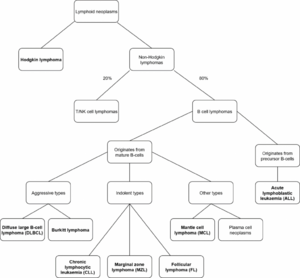Non-Hodgkin lymphoma: Difference between revisions
(Created page with "'''Non-Hodgkin lymphomas''' (NHLs) are a heterogenous group of lymphomas. We distinguish indolent/low-grade NHLs, aggressive/high-grade NHLs, and intermediary NHLs. The indolent/low-grade non-Hodgkin lymphomas are much less harmful than the aggressive/high-grade ones. In many cases, patients die ''with'' indolent lymphomas rather than ''of'' them. They remain asymptomatic for many years and are therefore often diagnosed incidentally on a laboratory test rat...") |
(No difference)
|
Revision as of 09:44, 23 October 2023
Non-Hodgkin lymphomas (NHLs) are a heterogenous group of lymphomas. We distinguish indolent/low-grade NHLs, aggressive/high-grade NHLs, and intermediary NHLs.
The indolent/low-grade non-Hodgkin lymphomas are much less harmful than the aggressive/high-grade ones. In many cases, patients die with indolent lymphomas rather than of them. They remain asymptomatic for many years and are therefore often diagnosed incidentally on a laboratory test rather than due to the patient presenting with symptoms.
In some cases, they may not even require treatment, as they progress so slowly. Even untreated, the life expectancy is multiple years. The tumor cells don’t proliferate fast. In most cases, indolent lymphomas are uncurable due to their slow growth. Indolent NHLs are more frequent in older patients.
Aggressive lymphomas are very aggressive malignancies, as they proliferate rapidly and untreated the life expectancy is just a few weeks. They can be considered “high-grade”. However, thanks to their rapid growth, they are potentially curable. They are more frequent in children.
Classification

85% of non-Hodgkin lymphomas originate from B-cells. The different types of NHLs are shown in the figure.
The most common NHL is DLBCL, followed by follicular lymphoma.
Staging
The staging system for lymphomas is called the Lugano staging system, which is a modified version of the Ann Arbor staging. It is similar to the TNM staging system. It works like this:
- Stage I – cancer in a single region, usually one lymph node and the surrounding area
- Stage II – cancer in more lymph node regions, on one side of the diaphragm
- Stage III – cancer in more lymph node regions, on both sides of the diaphragm
- Stage IV – cancer in one or more extralymphatic organs, like the bone marrow, liver or lung
Also, several modifiers are used:
- E – if there is extranodal involvement
- A – if there are no “B symptoms”
- B – if there are B symptoms
- X – larger than 10 cm mass – called “bulky disease”
Stages I and II are referred to as “early stage” while stages III and IV are referred to as “advanced stage”.
Clinical features
The clinical features differ between high grade and low grade NHLs, although there might be some overlap:
- Low grade
- Lymphadenopathy which may fluctuate or spontaneously remit, and
- Hepatosplenomegaly
- Cytopaenias
- High grade
- Rapidly growing lymph nodes or masses
- B symptoms
Some NHLs present in extranodal tissues, for example as GI polyps (mantle cell lymphoma).
Diagnosis and evaluation
Excisional biopsy of the affected lymph node with immunohistochemistry and flow cytometry gives the diagnosis. Cytogenetic and molecular analysis can show chromosomal changes and mutations which are specific for each subtype.
Bone marrow biopsy and aspirate are necessary to detect bone marrow involvement. Lumbar puncture to look for CNS involvement is indicated in case of T-cell NHL, AIDS, or high grade lymphoma with positive blood marrow.
Treatment
Treatment options for NHLs include:
- Indolent NHLs
- Watch and wait (observation and follow-up)
- Monotherapy with alkylating agent
- R-CHOP
- Allogenic stem cell transplantation
- Aggressive NHLs
- Early stage -> R-CHOP ± radiotherapy
- Advanced stage -> R-CHOP, sometimes intrathecal chemotherapy and radiotherapy
The R-CHOP regimen involves rituximab, cyclophosphamide, doxorubicin (hydroxydaunorubicin), vincristine (Oncovin®), and prednisone. Rituximab is an anti-CD20 antibody and is only given if the disease is CD20+.
